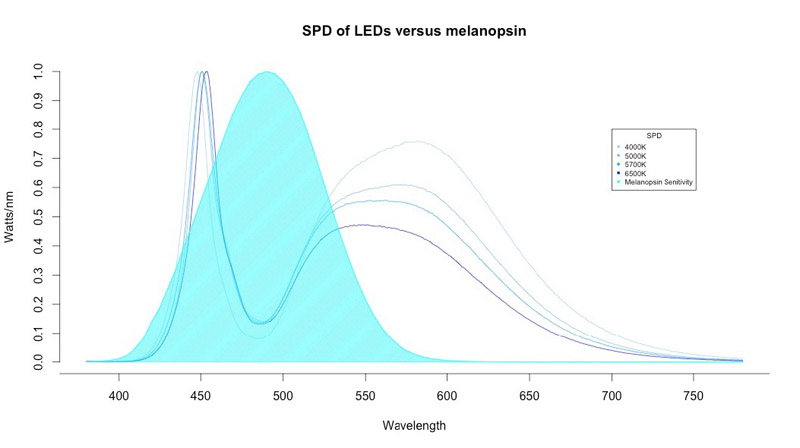Circadian Lighting – Does the spectrum hold the key?
If you listen closely, the whooshing sound you’re hearing is the market uptake of LEDs. They are nearly everywhere and where they are not, they will be soon. One of the areas into which LEDs are rapidly expanding is “circadian lighting.” Not long ago, researchers discovered that our sleep cycles can be interrupted if we are exposed to light at night. Since then, the challenge became to determine the quantity, frequency, and duration of the light. In other words, the dosage. However, at this point, the consensus seems to be that there is much more we don’t know than there is we do know about this phenomenon.
The lighting market was not content to wait for the results of further study and went about providing solutions to a problem that, at best, wasn’t clearly defined and, at worst, wasn’t needed. What has resulted is the new market space called circadian lighting. Generally speaking, circadian lighting refers to a luminaire or system of luminaires that shift the color appearance of the light produced over time to mimic the passage of the sun through the sky from sunrise to sunset. The intent is that this shift will cause similar physiological responses in humans that are triggered by the sun.
For the most part, these circadian lighting systems require two components – a luminaire that can shift color within a range and a control system to tell the luminaire what color it should produce and when. The early systems were clumsy, cumbersome, and costly. The systems have become less of the above but have not jumped the chasm to enable widespread adoption.
Ongoing research in the fields of vision and optogenetics has discovered that our visual system has two functions in a similar way that our ear has two functions. While the ear lets us hear and maintain our balance, our eyes let us see and help regulate our circadian response. The cues we receive from the daily light-dark cycle to light are received in the eye and sent down a non-visual neural pathway called the retinohypothalamic tract (RHT). It is in the RHT where researchers discovered intrinsically photosensitive retinal ganglion cells (ipRGC). The ipRGCs connect the RHT to the suprachiasmatic nucleus (SCN). In mammals, the SCN is the controlling clock component that generates a 24-hour rhythm and is located in a part of the brain called the hypothalamus. The SCN produces the signals that can keep the rest of the body on an approximately 24-hour schedule.
But if the SCN receives its signals through a non-visual pathway, why are lighting manufacturers shifting the appearance of the lighting? That is a good question to which I don’t know the answer. One light source manufacturer, BIOS Lighting, has begun to tackle that question from a light spectrum angle.
The visible spectrum is the portion of electromagnetic energy that is visible to the human eye. Within the visual spectrum, there are wavelengths which trigger certain chemical responses in the human body. A key human photoreceptor called melanopsin, which is critical in human sleep-wake cycles, has a peak sensitivity to the wavelength of visible light at approximately 490nm. However, most commercially-available LED sources are deficient in producing visible light around that region of the visible spectrum.
In a nutshell, as humans continue to spend more of their daylight hours indoors, we are receiving an increasingly weaker signal from the sun which suppresses melatonin and allows us to stay awake. This disruption in the melatonin production/suppression cycle, can affect our sleep/wake cycles in humans which has been shown to have negative impacts on human health.
In the graph below, the blue-shaded region illustrates the range of the action spectrum for melanopsin in humans. The wavy lines depict the amount of energy or “power” in the various wavelengths of light produced by a commercially available LED light source. You can see a dip, or trough, in the LED curve that aligns nearly perfectly with the peak of the melanopic action curve. What this means is that regular LEDs have less power in the range of that would help keep us more alert during the day.

Source: https://bioslighting.com/bios-skyblue-lighting-technology/
If there were an LED source that delivered more power within the range of the melanopic action spectrum, there may not be a need for complicated control systems and expensive color-changing luminaires.
Lighting professionals are increasingly being asked by clients to deliver lighting systems that support human health and well-being. The lighting community continues to grapple with the development of metrics, measurement, and guidelines for the proper integration of this research and knowledge into the professional practice of lighting design. There is much we still don’t know but while we continue to search for the answers the recommendations are pretty clear – limit screen time and get outside!

